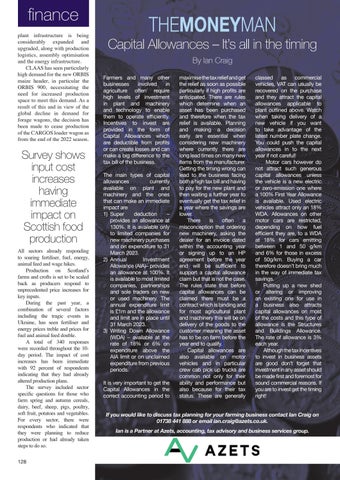finance plant infrastructure is being considerably expanded and upgraded, along with production logistics, assembly optimisation and the energy infrastructure. CLAAS has seen particularly high demand for the new ORBIS maize header, in particular the ORBIS 900, necessitating the need for increased production space to meet this demand. As a result of this and in view of the global decline in demand for forage wagons, the decision has been made to cease production of the CARGOS loader wagon as from the end of the 2022 season.
Survey shows input cost increases having immediate impact on Scottish food production
All sectors already responding to soaring fertiliser, fuel, energy, animal feed and wage hikes. Production on Scotland’s farms and crofts is set to be scaled back as producers respond to unprecedented price increases for key inputs. During the past year, a combination of several factors including the tragic events in Ukraine, has seen fertiliser and energy prices treble and prices for fuel and animal feed double. A total of 340 responses were recorded throughout the 10day period. The impact of cost increases has been immediate with 92 percent of respondents indicating that they had already altered production plans. The survey included sector specific questions for those who farm spring and autumn cereals, dairy, beef, sheep, pigs, poultry, soft fruit, potatoes and vegetables. For every sector, there were respondents who indicated that they were planning to reduce production or had already taken steps to do so. 128
THEMONEYMAN
Capital Allowances – It’s all in the timing By Ian Craig Farmers and many other businesses involved in agriculture often require high levels of investment in plant and machinery and technology to enable them to operate efficiently. Incentives to invest are provided in the form of Capital Allowances which are deductible from profits or can create losses and can make a big difference to the tax bill of the business. The main types of capital allowances currently available on plant and machinery and the ones that can make an immediate impact are 1) Super deduction – provides an allowance at 130%. It is available only to limited companies for new machinery purchases and on expenditure to 31 March 2023. 2) Annual Investment Allowance (AIA)– provides an allowance at 100%. It is available to most limited companies, partnerships and sole traders on new or used machinery. The annual expenditure limit is £1m and the allowance and limit are in place until 31 March 2023. 3) Writing Down Allowance (WDA) – available at the rate of 18% or 6% on expenditure above the AIA limit or on unclaimed expenditure from previous periods. It is very important to get the Capital Allowances in the correct accounting period to
maximise the tax relief and get the relief as soon as possible particularly if high profits are anticipated. There are rules which determine when an asset has been purchased and therefore when the tax relief is available. Planning and making a decision early are essential when considering new machinery where currently there are long lead times on many new items from the manufacturer. Getting the timing wrong can lead to the business facing both a high tax bill and having to pay for the new plant and then waiting a further year to eventually get the tax relief in a year where the savings are lower. There is often a misconception that ordering new machinery, asking the dealer for an invoice dated within the accounting year or signing up to an HP agreement before the year end will be sufficient to support a capital allowance claim but that is not the case. The rules state that before capital allowances can be claimed there must be a contract which is binding and for most agricultural plant and machinery this will be on delivery of the goods to the customer meaning the asset has to be on farm before the year end to qualify. Capital allowances are also available on motor vehicles and in particular crew cab pick up trucks are common not only for their ability and performance but also because for their tax status. These are generally
classed as commercial vehicles, VAT can usually be recovered on the purchase and they attract the capital allowances applicable to plant outlined above. Watch when taking delivery of a new vehicle if you want to take advantage of the latest number plate change. You could push the capital allowances in to the next year if not careful! Motor cars however do not attract such generous capital allowances unless the vehicle is a new electric or zero-emission one where a 100% First Year Allowance is available. Used electric vehicles attract only an 18% WDA. Allowances on other motor cars are restricted, depending on how fuel efficient they are, to a WDA at 18% for cars emitting between 1 and 50 g/km and 6% for those in excess of 50g/km. Buying a car therefore doesn’t bring much in the way of immediate tax savings. Putting up a new shed or altering or improving an existing one for use in a business also attracts capital allowances on most of the costs and this type of allowance is the Structures and Buildings Allowance. The rate of allowance is 3% each year. Although the tax incentives to invest in business assets are good don’t forget that investment in any asset should be made first and foremost for sound commercial reasons. If you are to invest get the timing right!
If you would like to discuss tax planning for your farming business contact Ian Craig on 01738 441 888 or email ian.craig@azets.co.uk. Ian is a Partner at Azets, accounting, tax advisory and business services group.

















































